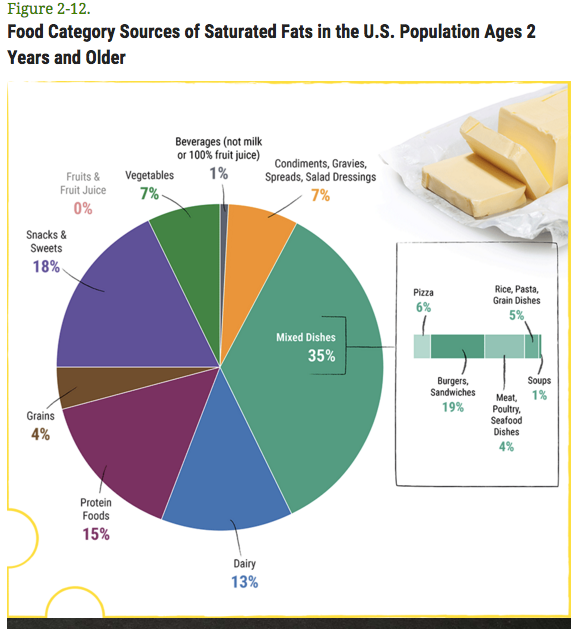
As of today, as far as the government is concerned, it is no longer possible to eat "too much" total fat.
You don’t have to worry about the cholesterol count in your food as much, and for the first time, there is a hard limit on added sugar, which should make up no more than 10 percent of your daily calories.
These are just some of the biggest changes to the 2015 Dietary Guidelines for Americans, the new federal dietary guidelines that launched today. While there are a few reasons to be excited about the document's potential to improve Americans' diets, on the whole it's the same as it has always been: too focused on nutrients, reluctant to take a stance on meat and environmental sustainability, and too obtuse for practical use.
Released every five years and jointly crafted by the U.S. Departments of Agriculture and Health and Human Services, the DGAs set the agenda for major food policy, including government assistance programs like school lunches and food benefits for mothers and children. The guidelines also set the standards for food and nutrition education and, ideally, help individuals decide how to eat for better health.
Some of the newest guidelines won't be a surprise to those who have been paying attention: A committee of independent scientists and researchers released a report in Feb. 2015 that summarized the latest nutrition research for the government's consideration. Other committee suggestions, however, were not adopted.
But Miriam Nelson, a member of that committee and a nutrition professor at Tufts University, points out that America is at an “inflection point” when it comes to caring about food, food policy and health. The nearly 30,000 public comments on the advisory report that Nelson and others wrote, as well as unprecedented media coverage of their recommendations, are signs that the general public is ready and willing to get into the nitty-gritty of what is and isn’t healthy to eat.
"People are starting to wake up and realize how important it is,” Nelson concluded. “There is an engagement in this whole topic that we haven’t seen before, and I think that’s a good thing."
What's the same

Sodium
In keeping with the last guidelines issued in 2010, the government still advises people to eat less than 10 percent of their calories from saturated fat and less than 2,300 mg of sodium (salt) every day.
But in a broader sense, the guideline continues the government's confusing and obtuse tradition of telling people what NOT to eat in terms of percentages, nutrients and calories. Trying to advise people to limit nutrients by percentage of calories is of almost no practical use to the average American, said Charles Mueller, an associate professor of clinical nutrition at New York University.
“It’s ludicrous,” said Mueller, who was not involved in the creation of the dietary guidelines. “You can’t do it without [a professional] calculating a diet for them.”
Instead, recommendations by food group and food type are the clearest and simplest way to advise people on their diet.
Saturated fat
The independent advisory committee’s report contained explicit warnings to lower red meat and processed meat consumption. But these warnings are nowhere to be found in the DGA's finalized five "overarching guidelines,” the document's topline summary. Instead, they're buried deep in the guidelines, where they vaguely suggest:
Lower intakes of meats, including processed meats; processed poultry; sugar-sweetened foods, particularly beverages; and refined grains have often been identified as characteristics of healthy eating patterns.
"The evidence was strong, irrefutable -- and the political pressure from the meat industry was [also] so strong,” said Nelson. “And that’s unfortunate for the American population.”
As it stands, Mueller said, this saturated fat recommendation is just an opportunity for the processed food industry to label their products “low in saturated fat.”
“They haven’t gone all the way,” Mueller said about the finalized guidelines. “They’ve made a wonderful change in teaching people what foods to eat, but then revert to a percentage of nutrients [for foods to avoid]."
Environment
The scientific committee suggested that consideration for environmental sustainability be included in the DGA. Nutrition experts continue to be disappointed that this recommendation was shelved due to intense pressure from Congress and meat industry lobbyists, a decision that was confirmed in Oct. 2015.
Nelson said it's "short-sighted" to drop concerns about sustainability because it is supposedly not "within the scope" of the dietary guidelines.
“It’s short-sighted that there’s no nod to food security and food sustainability,” she concluded. “That was also [due to] political pressure."
What's different

Addressing real foods
Despite disappointment that the guidelines stuck to recommendations in confusing and esoteric calorie percentages, there are instances when the guidelines specifically name real foods that Americans should eat less often.
“Maybe they’ve opened the door for doing this even more in 2020,” said nutrition scientist Christopher Gardner of Stanford University, who did not help create the dietary guidelines. “That's what I’m a little excited about, because I think that this is the kind of incremental change that, unfortunately, is probably all that we can expect.”
For instance, in charts that explain where Americans get most of their saturated fat and sodium -- two things the guidelines say we should limit -- there is a category called “protein food.” It's a baffling euphemism for a division made up mostly of meat. But Gardner is hopeful because these charts also include specific mention of processed foods from which we get a lot of saturated fat, like pizza and burgers.
The guidelines also say that teen boys and men are eating more than they should of these so-called "protein foods," like meat, poultry and eggs. It's another promising change that Gardner highlighted.
And of course, the guidelines do name the whole, unprocessed food that officials think Americans should eat more often, including vegetables, fruits, whole grains and legumes. But they've never had a problem specifically calling out what foods we should be eating.

Real limits on added sugar
In addition to providing a cap on added sugar, the guidelines also include a chart of where Americans get most of their added sugars. The jargony term "sugar-sweetened beverages" is broken down into easily identifiable terms like soft drinks, sports and energy drinks and sweetened "fruit drinks."
Nelson hopes that the limit on added sugar will influence the Food and Drug Administration’s decision on including a line for added sugar in their forthcoming nutrition label guidelines.
"Right now, a consumer who wants to understand how much added sugar they get can’t do it,” said Nelson. “I can do it because I have three degrees in nutrition, but it’s almost impossible to do it unless it’s on the label."

Also on HuffPost:
